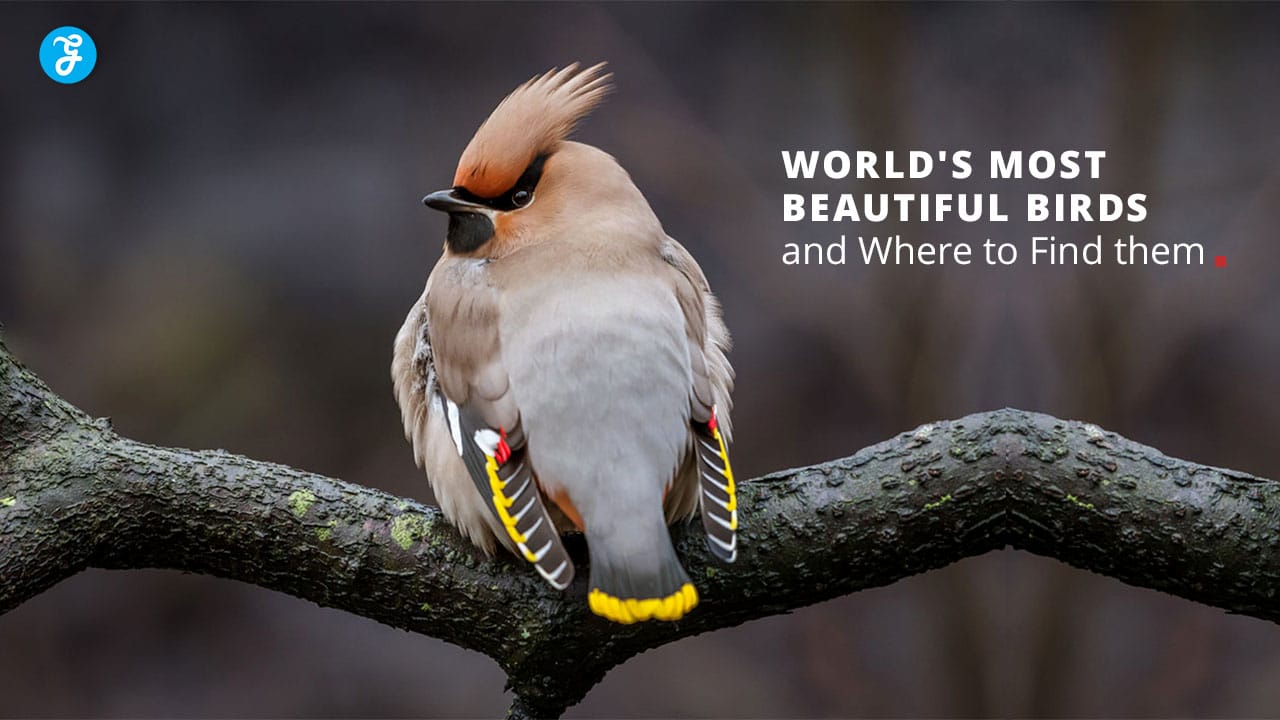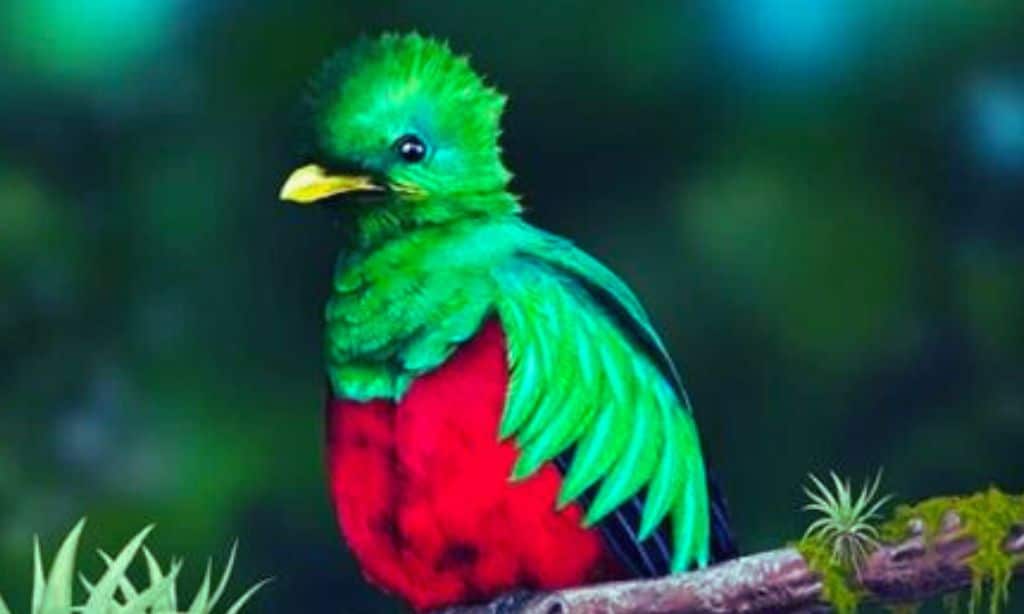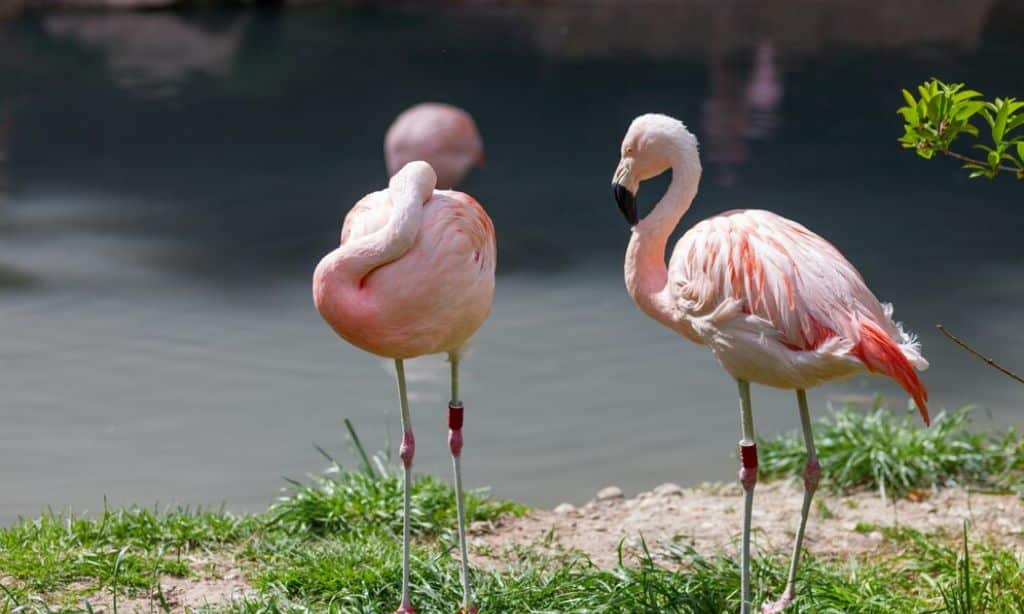Birds are nature’s living jewels. Their vibrant feathers and graceful movements catch the eye and lift the spirit. From tropical rainforests to snowy mountains, beautiful birds can be found all over the world.
You can spot some of the most stunning birds in places like the Amazon, Papua New Guinea, and even your own backyard.
This article will take you on a journey to discover 20 of the most beautiful birds on Earth. You’ll learn what makes each one special and where you might be lucky enough to see them in the wild.
1. Resplendent Quetzal, Central America
The resplendent quetzal is a stunning bird found in Central America. It’s known for its bright green feathers and long tail. Many people think it’s one of the most beautiful birds in the world.
You can find these birds in the tropical forests of countries like Costa Rica and Guatemala. They like to live in mountainous areas with lots of trees and clouds. These places are called cloud forests.
The quetzal is special to the people of Central America. It’s Guatemala’s national bird and appears on their flag. There’s even a legend about a Mayan prince who turned into a quetzal after fighting Spanish invaders.
Male quetzals are more colorful than females. They have bright red chests and long, green tail feathers. These tail feathers can grow up to 3 feet long! Females have shorter tails and less bright colors.
Quetzals eat mostly fruit, but they also catch small animals sometimes. They use their strong beaks to grab food from trees.
If you want to see a resplendent quetzal, you’ll need to visit a cloud forest in Central America. Costa Rica is a good place to start. The best time to see them is during breeding season, from March to June.
2. Hyacinth Macaw, South America
The hyacinth macaw is a breathtaking sight to behold. You’ll be amazed by its vibrant cobalt blue feathers that shimmer in the sunlight. This stunning bird is the largest parrot in the world, measuring up to one meter long from head to tail.
You can find these beautiful creatures in central and eastern South America. They call the tropical forests and grasslands of Brazil, Bolivia, and Paraguay home. Spotting one in the wild is a rare treat due to their endangered status.
Hyacinth macaws have powerful beaks that can crack open tough nuts and seeds. Their diet mainly consists of palm nuts, which they skillfully open with their strong jaws. You might see them hanging upside down from tree branches as they feed.
These birds are known for their intelligence and playful nature. They form strong bonds with their mates and can live for up to 50 years in the wild. Sadly, their numbers have declined due to habitat loss and illegal pet trade.
Conservation efforts are underway to protect these magnificent birds. If you want to see hyacinth macaws, your best bet is to visit protected areas in Brazil like the Pantanal wetlands. Remember to admire them from a distance and support ethical ecotourism practices.
3. Mandarin Duck, East Asia
The Mandarin duck is one of the most eye-catching birds you’ll ever see. These small waterfowl are native to East Asia, mainly China and Japan. You can spot them in wooded areas near lakes, ponds, and rivers.
Male Mandarin ducks are truly stunning. They have bright orange “sail fins” on their backs and colorful streaked cheeks. Their small red bills have white tips. Females are less showy but still pretty. They have gray heads with thin white rings around their eyes.
These ducks are loyal partners. They often pair for life and return to the same nesting spots year after year. During breeding season, males show off with fancy courtship displays to impress females.
In winter, Mandarin ducks move to warmer areas. After breeding, males shed their flashy feathers for a while. This temporary change helps them blend in better with their surroundings.
You might see Mandarin ducks in parks or lakes outside Asia too. Some have escaped from captivity and formed wild populations in other parts of the world. These beautiful birds are a treat to watch wherever you find them.
4. Atlantic Puffin, North Atlantic
The Atlantic Puffin is a charming seabird that will steal your heart. With its colorful beak and tuxedo-like plumage, it’s no wonder these birds are nicknamed “sea clowns.”
You can spot Atlantic Puffins along the coasts of the North Atlantic. They breed on islands from Canada to Norway, with Iceland being home to most of the world’s population.
These small birds are built for life at sea. Their wings may look tiny, but they’re perfect for “flying” underwater to catch fish. Puffins can dive up to 200 feet deep!
During breeding season, puffins gather in large colonies on rocky cliffs. They dig burrows in the ground to lay their single egg. Both parents take turns caring for the chick.
Want to see puffins up close? Visit places like Newfoundland, Maine, or the Shetland Islands between April and August. Bring binoculars for the best views of these adorable birds.
Atlantic Puffins face threats from climate change and overfishing. Conservation efforts are helping protect their breeding sites and food sources.
5. Peacock, India
The peacock is India’s national bird and a true marvel of nature. You’ll find these stunning creatures throughout the country, from lush forests to urban parks.
Peacocks are famous for their eye-catching tail feathers. Male peacocks spread these feathers in a fan-like display to attract females. The iridescent blue and green colors shimmer in the sunlight.
You can spot peacocks in many parts of India. The Viralimalai Peacock Sanctuary in Tamil Nadu is a great place to see them. It’s about 30 km from Tiruchirapalli and home to many wild peacocks.
Peacocks aren’t just pretty to look at. They play a key role in Indian culture and art. You’ll see peacock motifs in paintings, fabrics, and architecture across the country.
These birds are not just found in sanctuaries. You might see them in gardens, parks, or even roaming freely in some towns. They’re quite adaptable and can thrive in different habitats.
If you want to see peacocks, visit India between March and August. This is when males show off their feathers to attract mates. It’s a sight you won’t forget!
6. Flamingo, Africa
Flamingos are some of the most eye-catching birds you’ll ever see. Their bright pink feathers make them stand out in any landscape. You can find these beautiful birds in many parts of Africa.
The lakes of East Africa are great spots to see flamingos. Lake Nakuru in Kenya is famous for its large flocks. Sometimes, you can see over a million flamingos there at once!
Flamingos also live in other African countries. You might spot them in Tanzania, South Africa, and Namibia. They like shallow lakes and lagoons where they can find plenty of food.
These birds get their pink color from the food they eat. They feed on tiny shrimp and algae in the water. The more of this food they eat, the pinker they become.
Flamingos are social birds. You’ll often see them in large groups. They stand on one leg to keep warm and save energy. It’s quite a sight to see hundreds of flamingos doing this together!
The best time to see flamingos in Africa is during the dry season. This is when they gather in large numbers at lakes and wetlands. Plan your trip between June and October for the best chances of seeing these amazing birds.
7. Rainbow Lorikeet, Australia
Rainbow Lorikeets are stunning birds you’ll find in Australia. These colorful parrots have bright blue heads, orange chests, and green wings. Their vibrant feathers make them look like flying rainbows.
You can spot Rainbow Lorikeets in many parts of eastern Australia. They love cities and suburbs with lots of trees. Perth in Western Australia also has a population of these beautiful birds.
Rainbow Lorikeets are medium-sized, measuring 25-30 cm long. They weigh between 75-157 grams. Males and females look alike, so it’s hard to tell them apart.
These birds are social creatures. You’ll often see them in noisy flocks, feeding on nectar and pollen from flowers. They have special brush-tipped tongues to help them drink nectar.
If you want to see Rainbow Lorikeets, visit well-treed areas in Australian cities. Parks, gardens, and bushland are good spots to look. They’re active during the day, so you have a good chance of spotting them.
Rainbow Lorikeets have adapted well to urban life. This means you can often see them close to human homes and buildings. Their bright colors and cheerful calls make them popular with both locals and tourists.
8. Scarlet Macaw, Central and South America
The scarlet macaw is one of the most stunning birds you’ll ever see. These large parrots have bright red feathers covering most of their bodies.
You’ll also notice vibrant blue and yellow on their wings. Their long tail feathers add to their eye-catching appearance.
Scarlet macaws live in the rainforests of Central and South America. You can find them from southeastern Mexico down to the Amazon basin.
These birds need mature, undisturbed forests to thrive. They prefer humid evergreen areas at elevations around 1,000 feet.
Want to spot a scarlet macaw in the wild? Your best bet is to visit protected rainforest areas. Look high up in the forest canopy.
Scarlet macaws eat nuts, fruits, and seeds from the treetops. Their strong beaks help them crack open tough shells.
These beautiful birds face threats from habitat loss and capture for the pet trade. Many countries now have laws to protect them.
With their striking colors and graceful flight, scarlet macaws are truly a sight to behold. Seeing one in its natural rainforest home is an unforgettable experience.
9. Victoria Crowned Pigeon, New Guinea
The Victoria crowned pigeon is a sight to behold. You’ll find this stunning bird in the forests of New Guinea and nearby islands.
It’s hard to miss with its elegant blue lace-like crest and maroon breast. The crest has unique white tips that make it look like a royal crown.
This pigeon is huge. It can grow up to 75 cm long with a wingspan of 70 cm. That’s about the size of a turkey!
The Victoria crowned pigeon has striking red eyes. Its body is mostly bluish-gray, adding to its regal appearance.
You might hear this bird before you see it. It makes deep “whooping” sounds when calling.
Unlike city pigeons, these birds spend most of their time on the ground. They live in swamp forests and lowland areas.
Sadly, the Victoria crowned pigeon faces threats. Hunting and habitat loss have made it vulnerable.
To see this majestic bird, you’ll need to visit New Guinea. Look for it in protected areas where it can thrive safely.
Remember to respect its habitat if you’re lucky enough to spot one. These beautiful birds need our help to survive.
10. Golden Pheasant, China
The golden pheasant is one of the world’s most beautiful birds. You can find this stunning creature in the mountainous forests of central China.
Its feathers are a dazzling mix of colors. The male has a golden crest, bright red body, and long tail. Its wings show off blues, greens, and browns.
Female golden pheasants look different. They have duller brown feathers to blend in with their surroundings.
These birds are about the size of a chicken. They prefer to walk and run rather than fly.
Golden pheasants eat a varied diet. They munch on seeds, berries, leaves, and small insects.
You might hear them before you see them. They make loud calls, especially during mating season.
In China, people have long admired these birds. They appear in art and stories as symbols of beauty and nobility.
While native to China, you can now see golden pheasants in zoos worldwide. Some people also keep them as exotic pets.
If you want to spot one in the wild, you’ll need to be patient. These shy birds often hide in thick forest undergrowth.
11. Bali Bird of Paradise, Indonesia
The Bali Bird of Paradise is a stunning creature found in Indonesia. You’ll be amazed by its vibrant colors and unique appearance.
This bird has beautiful red and yellow feathers. Its tail is long and elegant, with two thin wires extending from the end. The body is small, about the size of a starling.
You can spot these birds in the forests of Bali. They prefer to live in the treetops, where they build their nests. The males put on spectacular displays to attract females during mating season.
Sadly, the Bali Bird of Paradise is very rare. Habitat loss and illegal hunting have made it endangered. Conservation efforts are underway to protect these beautiful birds.
If you want to see one, your best bet is to visit West Bali National Park. Guided tours can help you spot these elusive creatures in their natural habitat.
Remember to bring binoculars and stay quiet. These birds are shy and can be hard to find. But seeing one in person is truly a special experience.
12. Snowy Owl, Arctic Regions
The snowy owl is a stunning bird that calls the Arctic home. You can spot these majestic creatures in the tundra regions of North America and Eurasia.
Snowy owls have bright white feathers with dark markings. Their plumage helps them blend in with the snow-covered landscape. These birds are large, with wingspans reaching up to 5 feet.
You’ll be amazed by the snowy owl’s hunting skills. They have excellent eyesight and hearing to catch their prey. Lemmings and voles are their favorite meals, but they also eat other small mammals and birds.
Snowy owls are well-adapted to the harsh Arctic climate. Their thick feathers cover even their feet, keeping them warm in freezing temperatures.
If you want to see a snowy owl, your best bet is to visit the Arctic tundra during summer. That’s when these birds are most active, taking advantage of the long daylight hours to hunt.
Sometimes, snowy owls fly south for the winter. You might spot them in fields or coastal areas in the northern United States and Canada.
These beautiful birds face threats from climate change and habitat loss. Conservation efforts are important to protect snowy owls and their Arctic home.
13. Blue Jay, North America
Blue jays are stunning birds found across eastern North America. You’ll spot these eye-catching creatures in forests, parks, and backyards.
Blue jays have bright blue feathers on their backs and wings. Their bellies are light gray. A fluffy crest on top of their head adds to their charm.
These birds measure about 9-12 inches long. Their wingspan reaches 13-17 inches. Blue jays weigh between 2.5 to 3.5 ounces.
You can identify blue jays by their loud, harsh “jay” calls. They’re known for being clever and bold. Blue jays often visit bird feeders in groups.
To see blue jays, look in deciduous or mixed woodlands. They prefer mature forests with oak trees. You might also spot them in suburban areas with large trees.
Blue jays are year-round residents in most of their range. In winter, some northern birds may move south. This makes them easier to spot in southern states during colder months.
These beautiful birds play an important role in their ecosystems. They help spread acorns and other seeds, aiding forest growth. Blue jays also warn other birds of nearby predators.
14. Keel-billed Toucan, Central America
The keel-billed toucan is a sight to behold. With its rainbow-colored bill and bright plumage, it’s no wonder this bird catches your eye.
You’ll find these colorful creatures in the tropical jungles of Central America. They range from southern Mexico all the way to Ecuador.
Belize has chosen the keel-billed toucan as its national bird. It’s easy to see why—these birds are stunning ambassadors for the country’s natural beauty.
These toucans are medium-sized, measuring about 20 inches long. Their famous bill makes up a third of that length. Don’t worry, though – the bill is light and hollow, not heavy at all.
Keel-billed toucans have black bodies with yellow chests and faces. Their bills are a mix of green, orange, red, and blue. It’s like they’re carrying a rainbow on their face!
These birds aren’t picky eaters. They munch on fruits, seeds, insects, and even small lizards or snakes. Their long bills help them reach food in tricky spots.
Want to spot one? Look up in the forest canopy. Keel-billed toucans prefer to hang out high in the trees. Listen for their frog-like croaking calls to guide you.
15. European Robin, Europe
The European Robin is a small but striking bird you can find across Europe. Its bright orange-red breast makes it easy to spot. This little bird is about the size of a sparrow.
European Robins live in many places. You can see them in gardens, parks, and woodlands. They like areas with trees and bushes where they can find food and shelter.
These birds eat insects, worms, and berries. They hop along the ground looking for food. In winter, they may visit bird feeders in gardens.
European Robins are known for their friendly behavior. They often come close to people, especially when gardening. This has made them popular birds in many European countries.
You can hear European Robins singing throughout the year. Their song is a series of clear, warbling notes. They sing even in winter, unlike many other birds.
To see a European Robin, visit any European country. They are common in the UK, Ireland, and across continental Europe. Look for them in parks or gardens, especially in the early morning or evening.
16. Kingfisher, Global
Kingfishers are some of the most beautiful birds you’ll ever see. These colorful hunters live on every continent except Antarctica. You can find them near water bodies like rivers, lakes, and coastal areas.
Kingfishers come in many sizes. The smallest is only 4 inches long, while the largest can reach 18 inches. Most have bright blue feathers, but some sport greens, reds, and oranges too.
Their most striking feature is their large, pointed bill. This helps them catch fish and other prey with pinpoint accuracy. You might spot a kingfisher perched on a branch, waiting patiently to dive for its next meal.
In North America, look for the belted kingfisher. It has a blue-gray body and a distinctive white collar. Australia is home to the famous laughing kookaburra, known for its unique call that sounds like laughter.
Africa boasts the giant kingfisher, the largest of its family. In Asia, you might see the collared kingfisher with its stunning turquoise plumage. Europe has the common kingfisher, a small but brilliantly colored bird.
To find kingfishers, visit quiet waterways early in the morning. Listen for their sharp, rattling calls. With patience, you might witness their impressive diving skills as they plunge into the water for fish.
17. Green-winged Teal, North America
The Green-winged Teal is a tiny duck that packs a big punch of beauty. You’ll find these charming birds across North America, from Alaska to Mexico.
Male Green-winged Teals sport a striking look. Their heads are cinnamon-colored with a green stripe running from the eye to the back of the neck. This splash of color gives them their name.
Female teals are less flashy but still lovely. They have brown feathers with speckled patterns. Both males and females show off green wing patches when they fly.
These ducks are small but speedy. They zoom through the air with quick wing beats. You might spot them in shallow ponds or flooded fields.
Listen for the male’s unique whistle. It doesn’t sound like your typical duck quack. This call helps set Green-winged Teals apart from other ducks.
Want to see these beauties up close? Look for them in wetlands during fall and spring. They often gather in large groups during migration.
Green-winged Teals are common across North America. Your best bet is to visit wildlife refuges or parks with wetland habitats. Bring binoculars to catch a glimpse of their colorful details.
18. Lilac-breasted Roller, Africa
The lilac-breasted roller is a dazzling bird found in sub-Saharan Africa. Its vibrant colors make it one of the most beautiful birds you’ll ever see.
This eye-catching bird has a lilac-colored breast, as its name suggests. Its back and wings are a mix of blue and green, while its head is light blue. The roller’s belly and tail are a striking turquoise.
You can spot lilac-breasted rollers in open woodlands and savannas across eastern and southern Africa. They like areas with scattered trees where they can perch and look for food.
These birds are about the size of a jay. They have a strong, slightly curved beak that helps them catch insects, their main food source. Sometimes they eat small reptiles and rodents too.
Lilac-breasted rollers got their name from their acrobatic flying displays. During mating season, you might see them doing barrel rolls and swoops in the air.
If you want to see these colorful birds, plan a trip to countries like Kenya, Tanzania, or Botswana. They’re common in many of Africa’s famous national parks and game reserves.
Remember to bring a good camera if you go looking for lilac-breasted rollers. Their bright feathers make for stunning photographs, especially against the backdrop of the African savanna.
19. Bohemian Waxwing, Northern Hemisphere
The Bohemian Waxwing is a stunning bird you’ll want to add to your birdwatching list. With its sleek gray plumage and distinctive crest, it’s a sight to behold.
These beautiful birds have some eye-catching features. Look for the black mask around their eyes and the bright yellow tips on their tail feathers. You might also spot red wax-like droplets on their wing feathers, which give them their name.
Bohemian Waxwings live in northern forests across North America and Eurasia. They breed in places like Alaska and northern Canada during the summer months.
In winter, these birds become nomads. They form large flocks and travel south in search of food. You might see them anywhere from the northern United States to parts of Europe and Asia.
What do Bohemian Waxwings eat? They love berries and fruits. In fact, they can eat hundreds of berries in a single day! They also catch insects in mid-air during the breeding season.
To spot these birds, keep an eye out for fruiting trees and shrubs. Waxwings often gather in large groups to feast on mountain ash, juniper, or crabapple trees.
The best time to see Bohemian Waxwings is from September to March. This is when they move south from their breeding grounds. Remember, their movements can be unpredictable as they follow food sources.
20. Roseate Spoonbill, Americas
The Roseate Spoonbill is a striking bird you won’t soon forget. Its vibrant pink feathers and unique spoon-shaped bill make it stand out in wetlands across the Americas.
You can spot these beautiful birds in coastal areas from Florida to Texas in the United States. They also live in parts of Central and South America.
Roseate Spoonbills get their pink color from the food they eat. Their diet includes small fish, crustaceans, and aquatic insects. These foods contain pigments that turn the birds’ feathers pink.
These birds have an unusual way of feeding. They swing their flat bills from side to side in shallow water. This helps them sift through mud to find tasty snacks.
Roseate Spoonbills often hang out in groups. You might see them with other wading birds like herons and ibises. The best time to watch them is early morning or late afternoon when they’re most active.
To see these pink beauties up close, visit wildlife refuges or coastal wetlands in their range. Bring binoculars and a camera to capture their unique features.
Birdwatching Best Practices
Spotting beautiful birds requires preparation and know-how. The right gear and knowledge of migration patterns can boost your chances of amazing sightings.
Essential Gear for Birdwatching
To get started, you’ll need some key items. A good pair of binoculars is a must. Look for ones with 8x or 10x magnification. A field guide helps you identify birds you see. Choose one specific to your area.
Comfortable shoes are important for long walks. Wear neutral colors to blend in with nature. Don’t forget a water bottle and snacks. A notebook and pen let you record your sightings.
A camera can capture memorable moments. If you use your phone, download a bird ID app. These apps can help you identify birds by sight or sound.
Seasonal Migration Patterns
Understanding when birds move helps you plan trips. Many birds migrate in spring and fall. Spring brings birds north to breed. Fall sees them head south for warmer weather.
Peak migration times vary by species and location. Coastal areas often see more birds during migration. Inland spots near water are good too.
Some birds, like Canada geese, travel in big V-shaped flocks. Others, like warblers, move in small groups. Weather affects migration. Birds often travel just after a cold front passes.
Check local birding reports to learn what’s moving through your area. Join a local birding group for expert tips on migration hotspots.
Habitats and Ecosystems
Beautiful birds live in many different places around the world. From lush jungles to swampy wetlands, these colorful creatures call diverse environments home.
Tropical Rainforests
Tropical rainforests are home to some of the world’s most stunning birds. You’ll find scarlet macaws flying through the Amazon’s tall trees. Their bright red feathers stand out against the green leaves. Toucans with huge, colorful beaks hop from branch to branch looking for fruit.
In Southeast Asian rainforests, you might spot the Nicobar pigeon. This bird has shiny blue-green feathers that shimmer in the sunlight. Quetzals live in Central American forests. The ancient Mayans valued their long tail feathers.
Rainforests give birds lots of food and places to hide. The warm, wet climate helps many plants grow. This means more seeds, fruits, and insects for birds to eat.
Wetlands and Marshes
Wetlands attract many eye-catching water birds. You can see pink flamingos wading through shallow lakes in Africa and South America. They use their curved beaks to scoop up tiny shrimp that give them their rosy color.
Mandarin ducks swim in ponds across East Asia. The males have bright orange “sails” on their backs and purple breast feathers. In North American marshes, you might spot a great blue heron. These tall birds stand still in the water, waiting to catch fish.
Wetlands give water birds places to nest and find food. The plants and mud help clean the water. This keeps fish and other prey healthy for the birds to eat.
Takeaway
The exploration of the world’s most beautiful birds reveals not only their stunning appearances but also the diverse ecosystems they inhabit.
Each bird, from the resplendent quetzal in Central America to the majestic snowy owl in the Arctic, plays a vital role in its environment, contributing to the ecological balance and cultural heritage of its region.
Conservation efforts are crucial to protect these avian wonders, as many face threats from habitat loss and climate change.
By appreciating their beauty and understanding their significance, we can foster a deeper connection to nature and motivate collective action towards their preservation.









































